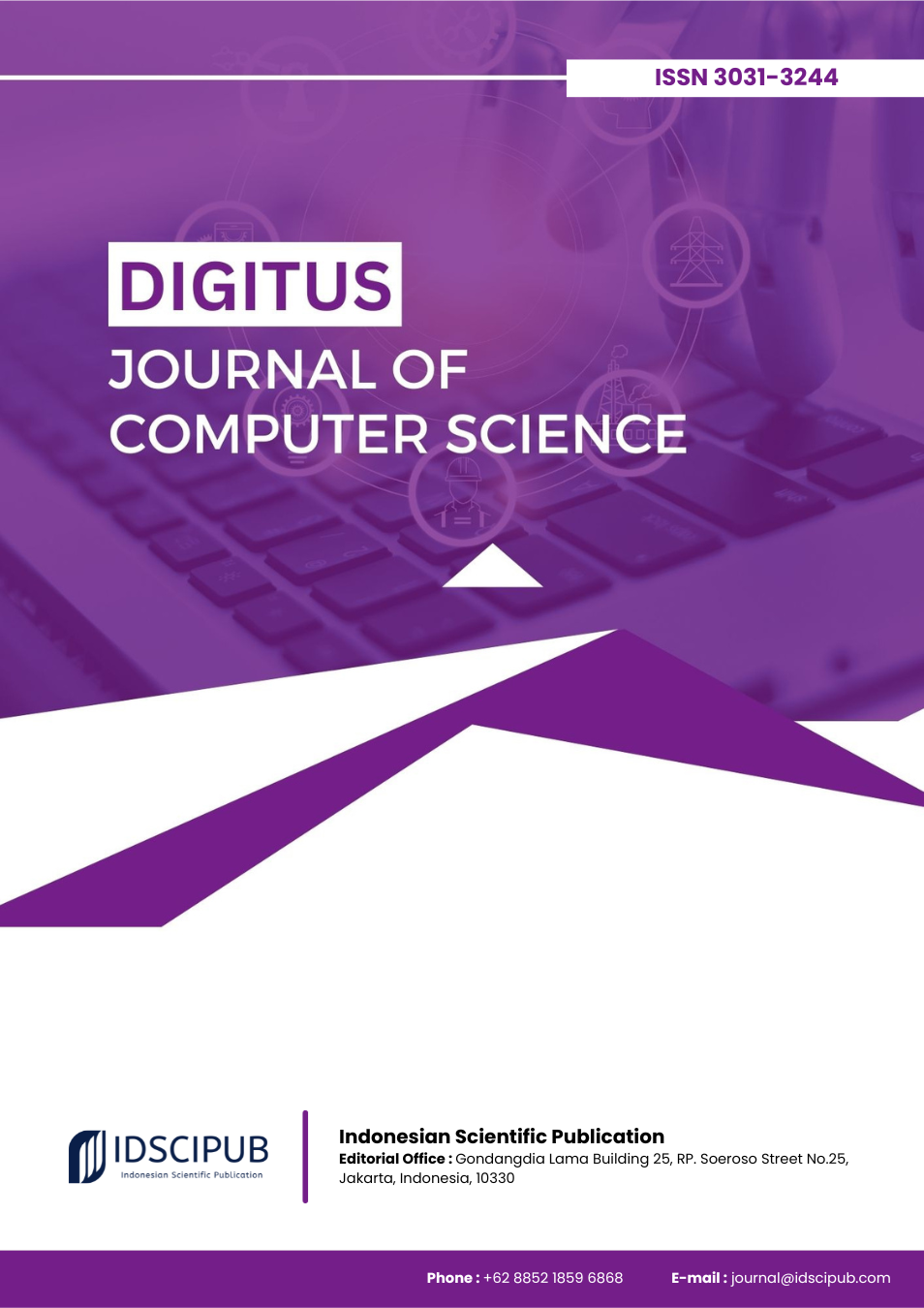Hybrid Deep Learning Models for Intrusion Detection in Cloud Networks: A Benchmark-Based Comparative Study
DOI:
https://doi.org/10.61978/digitus.v2i1.1116Keywords:
Intrusion Detection, Cloud Computing, Deep Learning, CNN, LSTM, Hybrid Architecture, Network Security, IDS EvaluationAbstract
The increasing complexity of cyber threats targeting cloud infrastructures demands advanced and adaptive intrusion detection systems (IDS). This study explores the application of deep learning (DL) models—Convolutional Neural Networks (CNN), Long Short-Term Memory networks (LSTM), and a hybrid CNN+BiLSTM architecture—for detecting network intrusions using benchmark datasets CIC-IDS2017 and UNSW-NB15. This study contributes by demonstrating how hybrid CNN+BiLSTM architectures enhance intrusion detection accuracy on benchmark datasets, offering low latency and improved recall for rare attack classes, thereby validating their suitability for real-time cloud security deployment. Results show that hybrid CNN+BiLSTM models outperform standalone CNN and LSTM architectures in detection performance, achieving accuracies up to 97.4% on CIC-IDS2017 and 96.85% on UNSW-NB15, while maintaining acceptable latency for real-time deployment. The hybrid model also demonstrates superior F1-scores for rare attack classes and lower false positive rates. The discussion highlights the importance of dataset quality, feature engineering, and the role of adversarial training and model optimization in enhancing robustness. In conclusion, this work affirms the value of hybrid DL architectures for cloud-based IDS and suggests future directions in federated learning, adaptive retraining, and deployment in edge environments.
References
Abdalgawad, N., Sajun, A. R., Kaddoura, Y., Zualkernan, I., & Aloul, F. (2022). Generative Deep Learning to Detect Cyberattacks for the IoT-23 Dataset. Ieee Access, 10, 6430–6441. https://doi.org/10.1109/access.2021.3140015 DOI: https://doi.org/10.1109/ACCESS.2021.3140015
Abosata, N., Al–Rubaye, S., & İnalhan, G. (2022). Customised Intrusion Detection for an Industrial IoT Heterogeneous Network Based on Machine Learning Algorithms Called FTL-CID. Sensors, 23(1), 321. https://doi.org/10.3390/s23010321 DOI: https://doi.org/10.3390/s23010321
Alaghbari, K. A., Lim, H. S., Saad, M. H. M., & Yong, Y. S. (2023). Deep Autoencoder-Based Integrated Model for Anomaly Detection and Efficient Feature Extraction in IoT Networks. Iot, 4(3), 345–365. https://doi.org/10.3390/iot4030016 DOI: https://doi.org/10.3390/iot4030016
Al-Hawawreh, M., Sitnikova, E., & Hartog, F. d. (2019). An Efficient Intrusion Detection Model for Edge System in Brownfield Industrial Internet of Things. 83–87. https://doi.org/10.1145/3361758.3361762 DOI: https://doi.org/10.1145/3361758.3361762
Aliabadi, M. S., & Jalalian, A. (2023). Detection of Attacks in the Internet of Things With the Feature Selection Approach Based on the Whale Optimization Algorithm and Learning by Majority Voting. https://doi.org/10.21203/rs.3.rs-2424464/v1 DOI: https://doi.org/10.21203/rs.3.rs-2424464/v2
Alshehri, M. S., Ahmad, J., Almakdi, S., Qathrady, M. A., Ghadi, Y. Y., & Buchanan, W. J. (2024). SkipGateNet: A Lightweight CNN-LSTM Hybrid Model With Learnable Skip Connections for Efficient Botnet Attack Detection in IoT. Ieee Access, 12, 35521–35538. https://doi.org/10.1109/access.2024.3371992 DOI: https://doi.org/10.1109/ACCESS.2024.3371992
Alsubhi, K. (2024). A Secured Intrusion Detection System for Mobile Edge Computing. Applied Sciences, 14(4), 1432. https://doi.org/10.3390/app14041432 DOI: https://doi.org/10.3390/app14041432
Alsumaidaee, Y. A. M., Yaw, C. T., Koh, S. P., Kiong, T. S., Chen, C. P., Yusaf, T., Abdalla, A. N., Ali, K., & Raj, A. (2023). Detection of Corona Faults in Switchgear by Using 1d-Cnn, LSTM, and 1d-CNN-LSTM Methods. Sensors, 23(6), 3108. https://doi.org/10.3390/s23063108 DOI: https://doi.org/10.3390/s23063108
Chung, W. H., Gu, Y. H., & Yoo, S. J. (2023). CHP Engine Anomaly Detection Based on Parallel CNN-LSTM With Residual Blocks and Attention. Sensors, 23(21), 8746. https://doi.org/10.3390/s23218746 DOI: https://doi.org/10.3390/s23218746
Devi, K., & Muthusenthil, B. (2022). Intrusion Detection Framework for Securing Privacy Attack in Cloud Computing Environment Using DCCGAN‐RFOA. Transactions on Emerging Telecommunications Technologies, 33(9). https://doi.org/10.1002/ett.4561 DOI: https://doi.org/10.1002/ett.4561
Elsaeidy, A., Jagannath, N., Sanchis, A. G., Jamalipour, A., & Munasinghe, K. S. (2020). Replay Attack Detection in Smart Cities Using Deep Learning. Ieee Access, 8, 137825–137837. https://doi.org/10.1109/access.2020.3012411 DOI: https://doi.org/10.1109/ACCESS.2020.3012411
El‐Sayed, A. A. I., Alsenany, S. A., Abdelaliem, S. M. F., & Asal, M. G. R. (2024). Exploring Organisational Agility’s Impact on Nurses’ Green Work Behaviour: The Mediating Role of Climate Activism. Journal of Advanced Nursing. https://doi.org/10.1111/jan.16551 DOI: https://doi.org/10.1111/jan.16551
Ferrag, M. A., Μαγλαράς, Λ., Moschoyiannis, S., & Janicke, H. (2020). Deep Learning for Cyber Security Intrusion Detection: Approaches, Datasets, and Comparative Study. Journal of Information Security and Applications, 50, 102419. https://doi.org/10.1016/j.jisa.2019.102419 DOI: https://doi.org/10.1016/j.jisa.2019.102419
Gamal, M., Abbas, H. M., Moustafa, N., Sitnikova, E., & Sadek, R. A. (2021). Few-Shot Learning for Discovering Anomalous Behaviors in Edge Networks. Computers Materials & Continua, 69(2), 1823–1837. https://doi.org/10.32604/cmc.2021.012877 DOI: https://doi.org/10.32604/cmc.2021.012877
Hnamte, V., Nguyen, H.-N., Hussain, J., & Kim, Y. (2023). A Novel Two-Stage Deep Learning Model for Network Intrusion Detection: LSTM-AE. Ieee Access, 11, 37131–37148. https://doi.org/10.1109/access.2023.3266979 DOI: https://doi.org/10.1109/ACCESS.2023.3266979
Javeed, D., Saeed, M. S., Ahmad, I., Kumar, P., Jolfaei, A., & Tahir, M. (2023). An Intelligent Intrusion Detection System for Smart Consumer Electronics Network. Ieee Transactions on Consumer Electronics, 69(4), 906–913. https://doi.org/10.1109/tce.2023.3277856 DOI: https://doi.org/10.1109/TCE.2023.3277856
Jin, Y., Cao, Q., Sun, Q., Lin, Y., Liu, D., Shan-Yu, Wang, C., Xiaoling, W., & Wang, X. (2024). Models for COVID-19 Data Prediction Based on Improved LSTM-ARIMA Algorithms. Ieee Access, 12, 3981–3991. https://doi.org/10.1109/access.2023.3347403 DOI: https://doi.org/10.1109/ACCESS.2023.3347403
Kumar, G., & Alqahtani, H. (2023). Machine Learning Techniques for Intrusion Detection Systems in SDN-Recent Advances, Challenges and Future Directions. Computer Modeling in Engineering & Sciences, 134(1), 89–119. https://doi.org/10.32604/cmes.2022.020724 DOI: https://doi.org/10.32604/cmes.2022.020724
Laghrissi, F., Douzi, S., Douzi, K., & Hssina, B. (2021). Intrusion Detection Systems Using Long Short-Term Memory (LSTM). Journal of Big Data, 8(1). https://doi.org/10.1186/s40537-021-00448-4 DOI: https://doi.org/10.1186/s40537-021-00448-4
Liang, Q., Shenoy, P., & Irwin, D. (2020). AI on the Edge: Rethinking AI-based IoT Applications Using Specialized Edge Architectures. https://doi.org/10.48550/arxiv.2003.12488 DOI: https://doi.org/10.1109/IISWC50251.2020.00023
Manjunatha, B. A., K, A. S., Naresh, E., Pareek, P. K., & Reddy, K. T. (2023). A Network Intrusion Detection Framework on Sparse Deep Denoising Autoencoder for Dimensionality Reduction. https://doi.org/10.21203/rs.3.rs-3107463/v1 DOI: https://doi.org/10.21203/rs.3.rs-3107463/v1
Rehman, A., Kashif, M., Jhaveri, R. H., Raut, R., Saba, T., & Bahaj, S. A. (2022). Deep Learning for Intrusion Detection and Security of Internet of Things (IoT): Current Analysis, Challenges, and Possible Solutions. Security and Communication Networks, 2022, 1–13. https://doi.org/10.1155/2022/4016073 DOI: https://doi.org/10.1155/2022/4016073
Shang, L., Zhang, Z., Tang, F., Cao, Q., Pan, H., & Lin, Z. (2023). CNN-LSTM Hybrid Model to Promote Signal Processing of Ultrasonic Guided Lamb Waves for Damage Detection of Metallic Pipelines. https://doi.org/10.20944/preprints202307.0929.v1 DOI: https://doi.org/10.20944/preprints202307.0929.v1
Shukla, P. K., Pandit, S. V., Gandhi, C., Alrizq, M., Alghamdi, A., Shukla, P. K., Venkatareddy, P., & Rizwan, A. (2024). Effective Privacy Preserving Model Based on Adversarial CNN With IBOA in the Social IoT Systems for CEC. International Journal of Communication Systems, 38(1). https://doi.org/10.1002/dac.5669 DOI: https://doi.org/10.1002/dac.5669
Spadaccino, P., & Cuomo, F. (2022). Intrusion Detection Systems for IoT: Opportunities and Challenges Offered by Edge Computing. Itu Journal on Future and Evolving Technologies, 3(2), 408–420. https://doi.org/10.52953/wnvi5792 DOI: https://doi.org/10.52953/WNVI5792
Tang, T. A., Mhamdi, L., McLernon, D., Zaidi, S. A. R., & Ghogho, M. (2016). Deep Learning Approach for Network Intrusion Detection in Software Defined Networking. https://doi.org/10.1109/wincom.2016.7777224 DOI: https://doi.org/10.1109/WINCOM.2016.7777224
Tareq, I., Elbagoury, B. M., El-Regaily, S. A., & El-Horbaty, E.-S. M. (2024). Deep Reinforcement Learning Approach for Cyberattack Detection. International Journal of Online and Biomedical Engineering (Ijoe), 20(05), 15–30. https://doi.org/10.3991/ijoe.v20i05.48229 DOI: https://doi.org/10.3991/ijoe.v20i05.48229
Teuffenbach, M., Piątkowska, E., & Smith, P. A. (2020). Subverting Network Intrusion Detection: Crafting Adversarial Examples Accounting for Domain-Specific Constraints. 301–320. https://doi.org/10.1007/978-3-030-57321-8_17 DOI: https://doi.org/10.1007/978-3-030-57321-8_17
Thakkar, A., & Lohiya, R. (2021). Analyzing Fusion of Regularization Techniques in the Deep Learning‐based Intrusion Detection System. International Journal of Intelligent Systems, 36(12), 7340–7388. https://doi.org/10.1002/int.22590 DOI: https://doi.org/10.1002/int.22590
Tian, W., Zhang, S., Gao, Y., Wang, Y., & Cui, Q. (2024). Drug Utilization Reviews to Reduce Inappropriate Drug Use and Pharmaceutical Costs in Inpatients Based on Diagnosis-Related Group Data. Technology and Health Care, 32(6), 4353–4363. https://doi.org/10.3233/thc-240284 DOI: https://doi.org/10.3233/THC-240284
Toldinas, J., Venčkauskas, A., Damaševičius, R., Grigaliūnas, Š., Morkevičius, N., & Baranauskas, E. (2021). A Novel Approach for Network Intrusion Detection Using Multistage Deep Learning Image Recognition. Electronics, 10(15), 1854. https://doi.org/10.3390/electronics10151854 DOI: https://doi.org/10.3390/electronics10151854
Ullah, I., & Mahmoud, Q. H. (2022). Design and Development of RNN Anomaly Detection Model for IoT Networks. Ieee Access, 10, 62722–62750. https://doi.org/10.1109/access.2022.3176317 DOI: https://doi.org/10.1109/ACCESS.2022.3176317
Vembu, G., & Ramasamy, D. (2022). Optimized Deep Learning‐based Intrusion Detection for Wireless Sensor Networks. International Journal of Communication Systems, 36(13). https://doi.org/10.1002/dac.5254 DOI: https://doi.org/10.1002/dac.5254
Véstias, M., Duarte, R. P., Sousa, J. T. d., & Neto, H. C. (2020). Moving Deep Learning to the Edge. Algorithms, 13(5), 125. https://doi.org/10.3390/a13050125 DOI: https://doi.org/10.3390/a13050125
Wei, Y., & Shangguan, M. (2023). A Review of Deep Learning Based Intrusion Detection Systems. Highlights in Science Engineering and Technology, 56, 188–199. https://doi.org/10.54097/hset.v56i.10104 DOI: https://doi.org/10.54097/hset.v56i.10104
Zhong, W., Yu, N., & Ai, C. (2020). Applying Big Data Based Deep Learning System to Intrusion Detection. Big Data Mining and Analytics, 3(3), 181–195. https://doi.org/10.26599/bdma.2020.9020003 DOI: https://doi.org/10.26599/BDMA.2020.9020003





